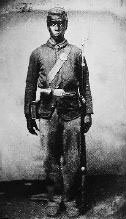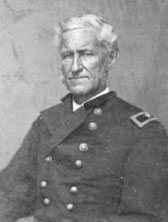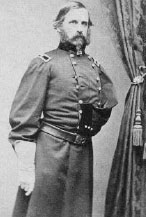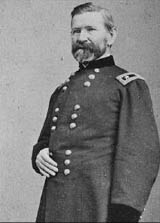The Bureau of Colored Troops
The Birth of the Organized Black Soldier
 On May 22, 1863 the United States War Department issued General Orders Number 143 establishing a specialized bureau within for the purpose of the organization of black enlisted troops. A pioneer program that would handle all matters related to the organization of these men of color. Only officers pre approved by the War Department would be worthy of recruiting such bodies and no authorization granted to any one man wishing to raise more than that of a single regiment. These infantrymen would be accepted in companies, and then consolidated into battalions and regiments, and the Adjutant General would number their unit by the order of their acceptance. They would become the United States Colored Troops, or USCTs.
On May 22, 1863 the United States War Department issued General Orders Number 143 establishing a specialized bureau within for the purpose of the organization of black enlisted troops. A pioneer program that would handle all matters related to the organization of these men of color. Only officers pre approved by the War Department would be worthy of recruiting such bodies and no authorization granted to any one man wishing to raise more than that of a single regiment. These infantrymen would be accepted in companies, and then consolidated into battalions and regiments, and the Adjutant General would number their unit by the order of their acceptance. They would become the United States Colored Troops, or USCTs.
 The Adjutant General of the Army, Brigadier General Lorenzo Thomas had thus organized nearly twenty regiments in Mississippi and had rendered valuable service at Vicksburg and elsewhere. Two federal regiments had already been recruited out of the state of Massachusetts, and one from the state of North Carolina by Brigadier General Edward Augustus Wild.
The Adjutant General of the Army, Brigadier General Lorenzo Thomas had thus organized nearly twenty regiments in Mississippi and had rendered valuable service at Vicksburg and elsewhere. Two federal regiments had already been recruited out of the state of Massachusetts, and one from the state of North Carolina by Brigadier General Edward Augustus Wild.
Recruiting stations in Philadelphia, Pennsylvania raised the Sixth and Eighth USCTs while Major General Robert Schenck began recruiting in Maryland with a station opened, and under the supervision of Colonel William Birney in Baltimore. The 4th and 7th USCTs were organized for federal service having been loosed from the local jails and slave pens that angered Baltimoreans had sent them off to. With the Confederacy’s inability to consider arming the slave in large organized bodies under arms, the Bureau of Colored Troops had a field day federalizing the United States Colored Troops from all over the country including South Carolina, Alabama, Mississippi, Louisiana, Arkansas and Tennessee.
and Eighth USCTs while Major General Robert Schenck began recruiting in Maryland with a station opened, and under the supervision of Colonel William Birney in Baltimore. The 4th and 7th USCTs were organized for federal service having been loosed from the local jails and slave pens that angered Baltimoreans had sent them off to. With the Confederacy’s inability to consider arming the slave in large organized bodies under arms, the Bureau of Colored Troops had a field day federalizing the United States Colored Troops from all over the country including South Carolina, Alabama, Mississippi, Louisiana, Arkansas and Tennessee.
 The screening board for white officers to lead these troops into combat was rigorous, the qualifications more stringent. By October of 1863 three boards for commissioning applications were established in Washington City, Cincinnati, Ohio and the third in St. Louis, Missouri. Of the fifteen hundred thirty four applicants five hundred seventeen of them were found qualified to lead them. Those officers rejected were mostly due to mental or physical disqualifications.
The screening board for white officers to lead these troops into combat was rigorous, the qualifications more stringent. By October of 1863 three boards for commissioning applications were established in Washington City, Cincinnati, Ohio and the third in St. Louis, Missouri. Of the fifteen hundred thirty four applicants five hundred seventeen of them were found qualified to lead them. Those officers rejected were mostly due to mental or physical disqualifications.
The following year the number of colored federal troops had grown from fifty eight regiments in 1863 to one hundred and forty of them rendering a manpower increase of over one hundred thousand blacks in uniform. They had fought with the political odds against them, however determined to see the war through, established for themselves respect from those in the War Department as well as the Executive Mansion.
There were no more questions whether the idea of the uniformed Negro would succeed. They fought with a dogged tenacity that rendered them an asset to help turn the tide of the war. President Lincoln’s other hand had just come out from behind his back and it packed a ferocious punch.
 Daniel Moran
Daniel Moran
© 2003
Editors Note: Mr.Moran is a feature writer on the US-Civilwar.com writers staff. He may be contacted with your questions, ideas and requests at dmoran@us-civilwar.net
Orders Establishing the…..
BUREAU OF COLORED TROOPS
====================================
United States Colored Troops
WAR DEPARTMENT
Adjutant General’s Office
Washington, May 22, 1863
GENERAL ORDERS, No. 143.
I. A Bureau is established in the Adjutant General’s Office for the record of all matters relating to the organization of Colored Troops. An officer will be assigned to the charge of the Bureau, with such number of clerks as may be designated by the Adjutant General.
II. Three or more field officers will be detailed as Inspectors to supervise the organization of colored troops at such points as may be indicated by the War Department in the Northern and Western States.
III. Boards will be convened at such posts as may be decided upon by the War Department to examine applicants for commissions to command colored troops, who, on application to the Adjutant General, may receive authority to present themselves to the board for examination.
IV. No persons shall be allowed to recruit for colored troops except specially authorized by the War Department; and no such authority will be given to persons who have not been examined and passed by a board; nor will such authority be given any one person to raise more than one regiment.
V. The reports of Boards will specify the grade of commission for which each candidate is fit, and authority to recruit will be given in accordance. Commissions will be issued from the Adjutant General’s Office when the prescribed number of men is ready for muster into service.
VI. Colored troops may be accepted by companies, to be afterwards consolidated in battalions and regiments by the Adjutant General. The regiments will be numbered seriatim, in the order in which they are raised, the numbers to be determined by the Adjutant General. They will be designated: “– Regiment of U.S. Colored Troops.”
VII. Recruiting stations and depots will be established by the Adjutant General as circumstances shall require, and officers will be detailed to muster and inspect the troops.
VIII. The non-commissioned officers of colored troops may be selected and appointed from the best men of their number in the usual mode of appointing non-commissioned officers. Meritorious commissioned officers will be entitled to promotion to higher rank if they prove themselves equal to it.
IX. All personal applications for appointments in colored regiments, or for information concerning them, must be made to the Chief of the Bureau; all written communications should be addressed to the Chief of the Bureau, to the care of the Adjutant General.
BY ORDER OF THE SECRETARY OF WAR:
E.D. Townsend,
Assistant Adjutant General
NOTE: Major Charles F. Foster, Assistant Adjutant General of U.S. Volunteers, was appointed Chief of the Bureau of the United States Colored Troops. He served in that position until October 1867.